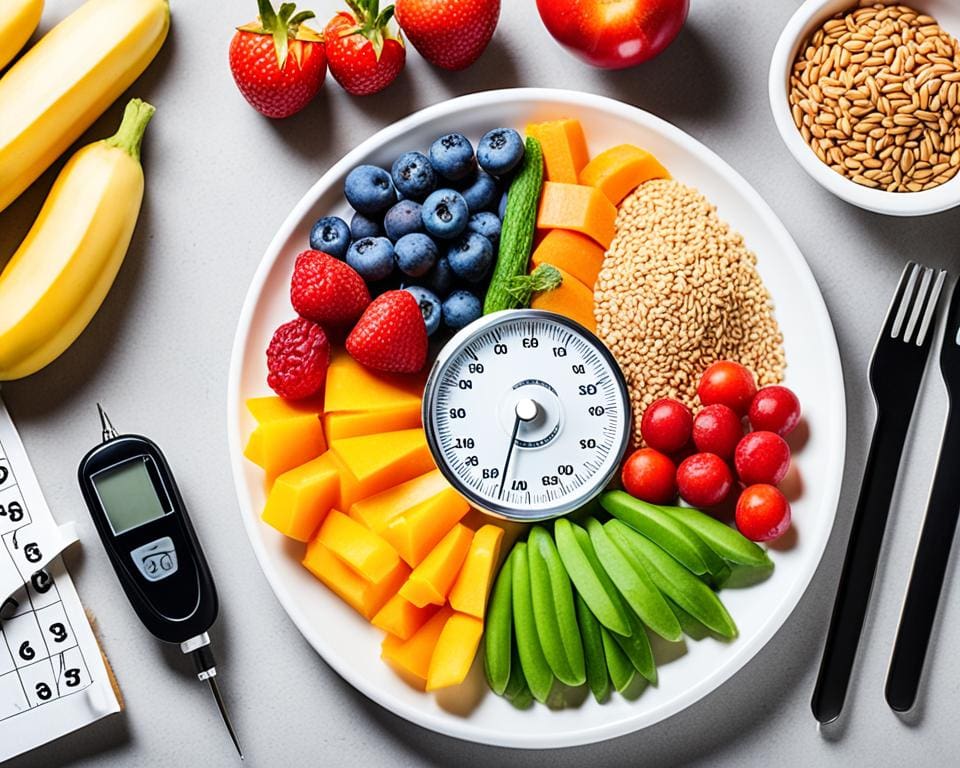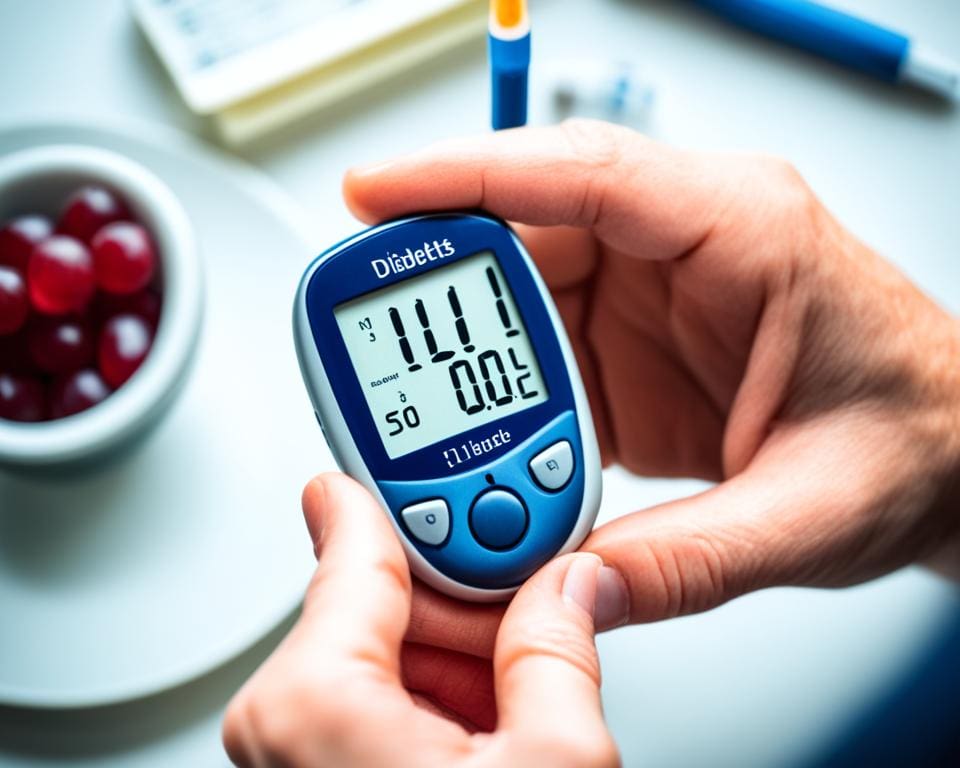Prediabetes is a warning sign for type 2 diabetes. It means your blood sugar levels are higher than they should be but not high enough for a diabetes diagnosis1. In the U.S., 96 million adults have prediabetes, and about one in three adults do1. Sadly, 80% of those with prediabetes don’t even know they have it1.
Prediabetes is often missed because its signs are not as clear as those of type 2 diabetes. The body starts to have trouble with insulin resistance, causing blood sugar levels to go up. If not treated, many with prediabetes will get type 2 diabetes within five years1.
Knowing the risk factors and signs of prediabetes is key. The risk goes up after you turn 45, and being overweight, especially with a big waist, raises your chances2. About 38% of American adults might have prediabetes, but only 19% know it2.
Key Takeaways:
- Prediabetes is a precursor to type 2 diabetes, affecting 96 million adult Americans.
- 80% of people with prediabetes are unaware they have the condition.
- Insulin resistance and elevated blood sugar levels characterize prediabetes.
- Risk factors include age over 45 and excess weight, particularly around the waist.
- Early detection and lifestyle changes can help reverse prediabetes and prevent progression to type 2 diabetes.
Understanding Prediabetes: A Precursor to Type 2 Diabetes

Prediabetes means your blood sugar levels are higher than they should be but not high enough for a type 2 diabetes diagnosis. The American Diabetes Association says prediabetes has an A1C level between 5.7% and 6.4%. It also includes a fasting plasma glucose level between 100 mg/dl and 125 mg/dl, or an oral glucose tolerance test level between 140 mg/dl and 199 mg/dl3. If not managed, prediabetes can turn into type 2 diabetes, making early detection and action key.
Defining Prediabetes and Its Significance
Prediabetes shows your body is having trouble with glucose because of insulin resistance. If not managed, it can lead to type 2 diabetes, a condition that can cause serious health problems. But, making lifestyle changes can lower your risk of getting type 2 diabetes4.
Only 5% to 10% of people with prediabetes will get type 2 diabetes5. This shows how important it is to act early and make lifestyle changes to manage prediabetes and stop it from becoming type 2 diabetes.
Risk Factors for Developing Prediabetes
Many things can up your risk of getting prediabetes and then type 2 diabetes. These include:
- Being overweight or obese
- Having a family history of type 2 diabetes
- Leading a sedentary lifestyle
- Having high blood pressure or abnormal cholesterol levels
- A history of gestational diabetes
- Being over the age of 45
Being African, Latino, or Native American, smoking, and taking certain medications like steroids, anti-psychotics, and HIV medication can also raise your risk of insulin resistance.
Medical conditions linked to insulin resistance include obstructive sleep apnea, fatty liver disease, polycystic ovarian syndrome (PCOS), Cushing’s syndrome, and lipodystrophy syndromes.
Knowing these risk factors and making lifestyle changes can lower your chance of getting prediabetes and type 2 diabetes. Studies show that eating better and moving more are better than meds for improving insulin sensitivity4. For those with prediabetes, doing 150 to 300 minutes of exercise a week is advised4.
Increased Thirst and Frequent Urination
People with prediabetes often feel more thirsty and need to pee more. These signs come from the body’s trouble controlling blood sugar levels6. High blood sugar can cause a condition called diabetes insipidus, making you drink and pee a lot7.

How Elevated Blood Sugar Affects Hydration
High blood sugar makes your kidneys work hard to filter out the extra glucose. If they can’t keep up, they send the sugar out as urine, taking fluids from your body and causing dehydration6. This dehydration makes you thirsty, and you’ll drink more to try to fix it6. Drinking a lot is a sign of diabetes and diabetes insipidus7.
Dehydration from drinking too much can cause nausea, dizziness, headaches, fainting, and high blood sugar that’s hard to control7.
The Connection Between Thirst and Frequent Urination
Drinking more to quench your thirst means you might pee more often, especially at night6. This is your body’s way of getting rid of the extra sugar. As prediabetes gets worse, you’ll notice these symptoms more6. High blood sugar and peeing a lot can make you very thirsty, especially if you have prediabetes or diabetes7.
If you keep feeling thirsty and peeing a lot, see your doctor. Catching prediabetes early helps you manage it better, so you can live a healthy life6.
Persistent Fatigue and Lethargy
Fatigue is a common issue in diabetes, not just when diabetes is not well-controlled. It can also happen even when blood sugar levels are under control8. Studies show that many people with both type 1 and type 2 diabetes feel tired all the time8. In fact, 61% of those newly diagnosed with Type-2 diabetes often feel tired during the day9.
When your body can’t use insulin well because of prediabetes, it affects how your body uses glucose for energy. This can make you feel tired or exhausted, even if you get enough sleep. Research shows that changes in muscle chemistry and mental health also play a big part in feeling tired8.

Diabetes fatigue syndrome (DFS) comes from many different factors, like your lifestyle, what you eat, your health, your mental state, and your diabetes8. Being overweight can make people with type-2 diabetes feel even more tired and lazy9. Studies have looked into how fatigue is linked to inflammation, being overweight, insulin treatment, and feeling depressed8. This shows how diabetes and fatigue can feed into each other, making things worse8.
Fatigue is physical and mental exhaustion that can really lower your quality of life8.
High or low blood sugar can drain your energy, making you feel unusually tired or lazy. It can also make your brain feel foggy, making it hard to focus or do everyday tasks. People with diabetes are 20% more likely to get depression than those without it9. This can make you feel even more tired and lazy.
To fight diabetes-related fatigue, it’s key to manage it well. Changing your lifestyle, like eating better and moving more, can help9. Eating right is important for keeping your blood sugar stable9. Getting 7-9 hours of sleep each night can also help9. Plus, managing stress and getting support from loved ones can make a big difference9.
It’s important to know that chronic fatigue syndrome is different from diabetes fatigue syndrome8. If you’re always feeling tired or lazy, talk to your doctor to find out why and get help. Understanding the link between diabetes and fatigue can help you take steps to boost your energy and improve your health.
Blurred Vision: A Warning Sign of Fluctuating Blood Sugar
Blurred vision is often linked to prediabetes and can signal changes in blood sugar levels. High blood sugar can change the shape of the eye’s lens, affecting vision. This happens because sugar makes the lens swell and change shape.
These vision changes can go up and down with blood sugar levels. If your body can’t handle blood sugar well, you might see blurred vision. Swelling of the eye lens and blurred vision can happen when blood sugar levels swing from low to normal10.

How Prediabetes Affects Eye Health
If prediabetes isn’t treated, it could turn into type 2 diabetes, causing serious vision problems. Diabetic retinopathy is a big risk, leading to blindness in many adults in the U.S1011.. Macular edema, caused by diabetes, can make vision blurry or distorted10. Glaucoma, especially neovascular glaucoma, can happen due to diabetes and harm vision10. People with diabetes often get cataracts earlier and faster10.
Diabetic retinopathy risk goes up with long diabetes history, poor blood sugar control, high blood pressure, high cholesterol, smoking, and being Black, Hispanic, or Native American11. Being diabetic before or during pregnancy also raises the risk11.
The Importance of Regular Eye Check-ups
Spotting prediabetes early can help control blood sugar and might even reverse vision issues. It’s key to get regular eye exams if you have prediabetes or diabetes. Experts suggest a yearly eye check-up with dilation for those with diabetes11. These exams are vital for catching diabetic eye diseases early10.
Eye exams for diabetes use drops to widen the pupils or a special camera for images. An AI system then checks these images for diabetic retinopathy10. If the AI says everything looks good, you might not need to see an eye doctor unless your vision gets worse. But if the AI finds problems, you’ll need a full eye exam10.
Managing diabetes and blood sugar, along with early action on vision issues, can prevent serious vision loss11. To fight diabetic eye diseases, control your blood sugar, blood pressure, and cholesterol. Quit smoking and protect your eyes from harmful rays1011.
Increased Hunger and Cravings
As prediabetes develops, you might feel hungrier and crave more food, even after eating a lot. This is called polyphagia or hyperphagia. It’s a common sign of diabetes, along with drinking a lot and needing to pee a lot12. This increased hunger comes from how your body reacts to insulin resistance, a key feature of prediabetes.

The Body’s Response to Insulin Resistance
In prediabetes, your cells don’t respond well to insulin. This hormone helps your body use glucose from the blood. So, glucose can’t get into your cells easily, causing high blood sugar levels13. Even with a regular diet, your body might not use glucose well, making you feel like you need more food. This leads to feeling very hungry and craving more12.
People with diabetic hyperphagia often feel hungry because of high or low blood sugar12. High blood sugar, over 140 mg/dL, means you need to adjust how you manage your diabetes13. Making changes to your diet and exercise can help control your blood sugar levels13.
To manage your blood sugar and reduce hunger, eating low-carb foods is key13. Try adding these foods to your meals:
- Non-starchy vegetables
- Lean protein sources
- Nuts and seeds
- Low-glycemic fruits
Drinking plenty of water also helps keep your blood sugar stable and can reduce hunger13. If you keep feeling very hungry and notice other diabetes symptoms like tiredness, drinking a lot, and needing to pee a lot, see a doctor quickly12. Catching prediabetes early and managing it can stop it from turning into type 2 diabetes.
Unexplained Weight Loss Despite Increased Appetite
One of the puzzling signs of prediabetes is losing weight even with a bigger appetite. This mix of weight loss and increased hunger could signal insulin resistance and type 2 diabetes early on. Losing 10 pounds or more without a clear reason might be a diabetes warning14. It’s key to know that losing more than 5% of your weight in 6 to 12 months could be serious15.

How Prediabetes Affects Weight Management
Prediabetes makes cells less responsive to insulin, a state called insulin resistance. This means glucose from food can’t get into cells for energy. So, the body starts burning fat and muscle for energy, leading to weight loss. This can be confusing and worrying.
Weight loss from diabetes often happens quickly, in weeks to a few months14. Unexplained weight loss is more common in Type 1 diabetes than Type 214. Studies show 15–20% of people over 65 experience this15.
The Paradox of Losing Weight While Eating More
The body’s response to insulin resistance leads to losing weight while eating more. When cells don’t react well to insulin, the body uses muscle and fat for energy. This can cause quick weight loss, even with a bigger appetite.
Weight loss from diabetes often comes with other signs like thirst, hunger, and fatigue14. If you lose weight without a clear reason and notice these symptoms, see a doctor. They can check for diabetes, cancer, or other health issues14.
| Gender | Associated Conditions |
|---|---|
| Males | Higher rates of endocarditis, pancreatic cancer, and lung cancer15 |
| Females | 2-10 times more likely to develop hyperthyroidism and 2-3 times more likely to have rheumatoid arthritis15 |
Doctors often miss unexplained weight loss as a symptom; only 21% of cases are recognized15. A quarter of people with unexplained weight loss don’t get diagnosed after a full medical check-up15. Knowing how unexplained weight loss relates to prediabetes helps you manage your weight and seek early help.
Strategies to Reverse Diabetes and Manage Prediabetes Symptoms
Managing prediabetes and stopping it from becoming Type 2 diabetes is doable with lifestyle changes and sometimes medication. Early detection and action are key. They help control blood sugar levels and lower the risk of serious problems like amputations, blindness, heart attacks, and stroke16. By acting now and checking your risk for prediabetes, you can start a healthier life path.
The Power of Lifestyle Changes
Adopting a healthy lifestyle is key to managing prediabetes. Losing 5-7% of your body weight can stop or slow down diabetes17. Also, doing at least 150 minutes of moderate exercise a week can cut the risk of Type 2 diabetes by up to 58%16. It’s important to lose weight in a healthy way, eating foods like fruits, veggies, nuts, beans, and lean proteins.
Studies show gut health is key in fighting Type 2 diabetes. So, eating a balanced diet is crucial.
Exercise is also key for managing prediabetes. Try to move more every day in ways you enjoy. Listen to your body, reduce stress, and do activities that help your insulin work better, like moderate exercise for 30 minutes a day18. Even small changes can greatly improve your health over time.
Importance of Early Detection and Intervention
Spotting prediabetes early is vital to stop it from becoming Type 2 diabetes. With 96 million American adults having prediabetes1718 and most not knowing it1618, regular check-ups are a must. Early action with lifestyle changes and medical help can better control blood sugar and lower complication risks.
If you think you might have prediabetes or have symptoms, act now. Use online tools to check your risk, talk to your doctor, and start making healthy changes. Remember, you can reverse prediabetes and prevent Type 2 diabetes with the right steps and support. Embrace lifestyle changes and early action for a healthier future for you and your family.
FAQ
What is prediabetes and why is it important to be aware of it?
Prediabetes means your blood sugar is higher than normal but not high enough for a diabetes diagnosis. It’s key to know about it because it can turn into type 2 diabetes if not managed. But, it often has mild symptoms that go unnoticed.
What are the risk factors for developing prediabetes?
Being overweight or obese, having a family history of type 2 diabetes, and a sedentary lifestyle increase your risk. High blood pressure, abnormal cholesterol, gestational diabetes history, and being over 45 also raise your chances. Smoking, certain medications, and some ethnicities can add to the risk.
How can increased thirst and frequent urination be related to prediabetes?
Prediabetes makes your kidneys work harder to filter glucose. If they can’t keep up, you lose more water, causing dehydration. This makes you thirsty and you drink more, leading to more bathroom breaks, especially at night.
Why does prediabetes cause persistent fatigue and lethargy?
Prediabetes makes it hard for your body to use insulin, affecting how it processes glucose for energy. This can lead to feeling tired or sluggish, even after resting. You might also feel mentally tired or have trouble focusing.
Can prediabetes affect eye health and vision?
Yes, high blood sugar from prediabetes can change the shape of your eye lens, causing blurry vision. These changes can go up and down with your blood sugar. If not treated, it could lead to serious vision problems.
Why do people with prediabetes experience increased hunger and cravings?
Cells in prediabetes don’t respond well to insulin, so glucose has trouble getting into cells for energy. This can make you feel like you’re not getting enough energy, even if you eat normally. Your body then tells your brain you need more food, making you hungry and craving more.
Is it possible to lose weight despite having an increased appetite due to prediabetes?
Yes, losing weight with a bigger appetite can be a sign of prediabetes. When insulin isn’t working right, your body can’t use glucose for energy. It starts burning fat and muscle instead, leading to weight loss even with eating more.
What strategies can help reverse prediabetes and manage its symptoms?
To reverse insulin resistance and prevent type 2 diabetes, try lifestyle changes, medication, or both. Eat healthy foods, exercise regularly, reduce stress, and listen to your body. Catching prediabetes early is key to managing and preventing type 2 diabetes.
Source Links
- https://blog.bonsecours.com/healthy/prediabetes-risk-factors-warning-signs/
- https://rosewellness.com/warning-signs-of-prediabetes/
- https://www.hopkinsmedicine.org/health/conditions-and-diseases/diabetes/prediabetes
- https://www.diabinfo.de/en/preventing-diabetes/diabetes/fact-check/what-is-prediabetes.html
- https://publichealth.jhu.edu/2022/what-is-prediabetes
- https://www.mayoclinic.org/diseases-conditions/diabetes/in-depth/diabetes-symptoms/art-20044248
- https://www.webmd.com/diabetes/diabetic-thirst
- https://www.ncbi.nlm.nih.gov/pmc/articles/PMC6064586/
- https://redcliffelabs.com/myhealth/diabetes/diabetes-fatigue-its-causes-how-to-manage-and-control-it/
- https://www.hopkinsmedicine.org/health/conditions-and-diseases/diabetes-and-your-eyes-what-you-need-to-know
- https://www.mayoclinic.org/diseases-conditions/diabetic-retinopathy/symptoms-causes/syc-20371611
- https://www.verywellhealth.com/hyperphagia-5114613
- https://diabetesfoodhub.org/blog/high-blood-sugar-and-hunger
- https://health.clevelandclinic.org/what-you-should-know-about-unexplained-weight-loss-and-diabetes
- https://www.healthline.com/health/unexplained-weight-loss
- https://health.clevelandclinic.org/how-to-reverse-prediabetes
- https://www.emoryhealthcare.org/stories/wellness/5-ways-to-reduce-or-even-reverse-diabetes
- https://www.byramhealthcare.com/blogs/10-effective-changes-you-can-make-to-help-reverse-prediabetes-fast























































